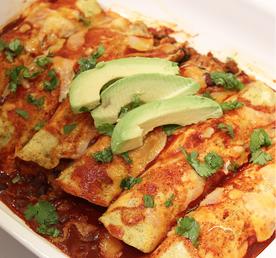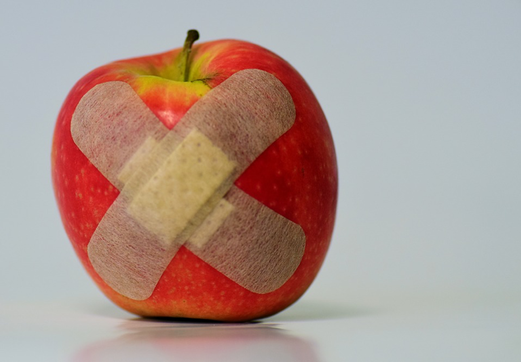 Burgers. Hotdogs. Chips. Potato salad. Nothing says summer like an outdoor barbecue and the typical food fare that comes along with it. With August just around the corner, you likely have a few of these events marked on your calendar. Consider the following suggestions to help you stay on top of your health and nutrition goals during barbecue season. 1. Portion Control Social gatherings centered on food can make it difficult to eat mindfully. Unlimited appetizers, multitasking and more variety in food options can all lead to overeating. Advice: take a small plate for appetizers, fill it up once. Do the same with a dinner-size plate for the main. By filling your plate at one time, you are more aware of the amount of food eaten and mindless snacking isn’t an issue. 2. Eat Your Veggies It’s easy to get your fill of starches and proteins with typical barbecue fare. But, don’t forget to eat your greens! Serve yourself vegetables first (ideally ½ your plate), then fill the rest of your plate with other foods (1/4 plate lean proteins + ¼ plate starches). Not sure if vegetables will be served at the party? Contact the host and offer to bring a salad or veggie tray. They will either thank you for your generosity, or, tell you that they already plan to offer these options. 3. Limit Condiments Some of the biggest culprits for hidden salt, fat, and sugar can be found in the condiment aisle. Sauces and dressings like ketchup, BBQ sauce, store-bought marinades, mayonnaise, and sour cream can pack a calorie punch. Advice: a little goes a long way! Try reducing the amount of condiments you use. Alternatively, flavor foods in different ways using spice rubs, herbs, lemon or vinegar. 4. Rethink Your Drink Cold beers go down pretty easily on a hot day. But calories from these, and other alcoholic beverages, can add up quickly. Pace yourself by staying hydrated with water in between. You can also make lower-calorie choices like wine spritzers, light beer, and tall mixed drinks (ideally with a non-caloric mixer or club soda). 5. Move More When you’re finished eating, move around! Play a game of horseshoes, toss a ball or go for a walk. Removing yourself from the table limits opportunities for mindless snacking. Bonus: you’ll fit in some activity and quality time with friends and family. Writer: Kerry Miller https://www.instagram.com/kerry.millerrd/
16 Comments
When I was diagnosed with type 1 diabetes 24 years ago, I took it like a champ. When I was blind-sided by a celiac diagnosis this past September, let's just say I did not embrace it quite so readily. I knew that type 1 diabetes and celiac are a common autoimmune pairing. We are all learning that celiac disease may present relatively asymptomatically. A persistent burning sensation on my tongue led me to ask and investigate; sure enough Celiac disease. Not having any stomach complaints, abnormal bowel movements, any major deficiencies, or weight loss, everyone was shocked.
Coming to terms with my new reality has not been easy. I wouldn’t even say that I have fully accepted it if I’m being honest. There is still an anger and sadness I get especially in social settings and travel. With 2 young kids at home, (kids love gluten) there’s other considerations, such as a costlier grocery bill, finding replacements for their gluten filled favourites, whether or not to keep my house totally gluten free (GF), and ensuring the nutritional needs of my household are met. The irony of living with type 1 diabetes and being a dietitian is that I am all too aware of the shortcomings of a GF diet. This goes beyond missing out on that flakey croissant; I’m talking about the nutrient density of my food. While GF diets have been trendy for weight loss, and diet fads like paleo, they are NOT necessarily healthier. Unfortunately for those with celiac disease, non-celiac related gluten sensitivity, and even IBS, a GF diet is often not a choice. And so, I am now among this GF community. And as I continue on my path of acceptance, and being a professional helping others eat for success, I have no choice but to make the best of this. With that, I am now setting goals to make my home a GF haven and taking the opportunity to experiment with new and exciting products, and recipes that don’t sacrifice taste OR nutrition. The reality is, GF products tend to be:
But don’t fret, there are so many wholesome grains and sources of carbohydrate still available to those following a GF diet. If you stick to whole foods and make an informed choice versus relying on the more processed, convenience foods such as breads, pastas, crackers, snack bars and cereals you won’t be missing a thing! So how do you make the best of a GF diet and can you make it as nutritious as one with gluten? The answer is most certainly YES. In honour of celiac awareness month, I wanted to share my key tips to making a GF diet tasty and nutritionally complete. 1. Adding fibres. Just because your store bought packaged items are lower in fibre, doesn’t mean your diet has to be. On average we should be getting between 22-35 g of dietary fibre daily. Fibre is great for heart health, keeping blood sugars stable, keeping you regular, adding satiety to your meal, and proven to lower your risk of colon cancer. A few ways I have incorporated healthy fibres into my GF diet include adding psyllium powder, and GF chia and ground flax seeds to smoothies, salads, yogurt and baked goods. If you’re experimenting with your own homemade breads and bakery items these can be easy add ins. Quick tip: you may need to add more liquid to compensate for the absorptive nature of these fibres. 2. Read labels. GF or not, I have always encouraged this for my clients whether it’s for weight loss, health, diabetes, or other chronic conditions. Yes, occasionally you’ll opt for the closest replica to your favourite glutinous item. But for items eaten on the regular seek out those with more fibre and protein per serving, and look for the key word ‘whole grain’. This means more of the nutrition is intact. Comparing labels can help you make an informed choice. For bread, local GF producers often have healthier items with fewer preservatives. For more commercial brands, Udi’s millet-chia loaf, and their omega flax and fibre loaf fit the bill for me. In the toaster the taste is good and offer 3g fibre and protein per slice! The price is more reasonable as well. Northern Bakehouse whole grain loaves are also texturally pleasing and offer about 3 g fibre per slice. Better yet, try making your own! 3. Pick whole foods. Another practice I preach to my GF and non-GF clients alike is to stick to the outer aisles. This is where your whole foods are found and everyone should be practicing this! It’s a cheaper way to shop too. Fruits, veggies, and starchy veg like squash, sweet potatoes, edamame, turnips and fresh corn provide complex carbohydrates to fuel your day. They provide soluble and insoluble fibres and are loaded with vitamins and minerals. The more variety and colour the better. Your minimally processed whole grains like GF certified quinoa, millet, oats, beans and brown rice are also safe and nutritious choices for your family’s plate. Fresh proteins, tofu, eggs, and dairy items are also found here (which are almost always GF), provide loads of nutrition and are minimally processed. I loved the creative use of leftover sweet potatoes in this recipe. A wholesome pancake, great for breakie, pre- workout or as a portable kid friendly snack; they were a hit in my house! • https://www.theleangreenbean.com/sweet-potato-protein-pancakes/ 4. Healthier flours. Sure there will be times that using a GF flour mix is the best and quickest option. But, I have had success with GF oat flour, almond, chickpea, and coconut flours as a base for delicious baked items and feel good about the lower glycemic effects and less refined quality of these options. Making your own baked goods for snacks, and kids’ lunch boxes is a great idea. Batch cook and freeze to save time. Again, I encourage this for both GF and non GF-clients because you can often pack-in more healthful ingredients like fruits, yogurts and applesauce to control the fat and sugar content too. Adding psyllium and GF ground seeds to the mix can further boost the fibre, protein and omega content of your recipe. I’m not known to be a baker, but I make these ones on the regular, minimal ingredients, done in the blender, and the kids love them! • https://glutenfreeonashoestring.com/healthy-gluten-free-banana-breakfast-muffins/ Writer: Debora Sloan (RD) Debora Sloan Healthy Solutions www.deborasloanhealthysolutions.com  This month's recipes are made by the winners of our Nutrition Month recipe competition! Congratulations! Recipe #1 Spinach and bacon omelette by Emelia Dermott Ingredients: 1 tbs. olive oil 4 strips of bacon chopped 8 cherry tomatoes 2 handfuls of spinach 4 eggs Pinch of salt and pepper Directions: 1. Chop bacon, spinach, and cherry tomatoes 2. Add chopped bacon to a heated pan and cook until golden on the edges, drain the excess fat and set cooked bacon aside 3. Add olive oil to pan 4. Whisk together tomatoes, spinach, cooked bacon, and eggs adding to heated pan over medium low heat 5. Cover the pan and let cook for about 6 mins or until desired cook 6. Add salt to taste Recipe #2 Breakfast Enchiladas by Laurel Dix (RDN, LD) Ingredients: 8 large eggs 1/4 cup low-fat milk 1 Tbsp olive oil 1 onion, chopped garlic, minced 1 lb 99% lean turkey 2 cups spinach 1 cup sliced cherry tomatoes 1 1/2 cups black beans 1/2 cup enchilada sauce 1/2 cup reduced fat shredded Mexican cheese Toppings: cilantro, avocado, salsa Directions: 1. Preheat oven to 350. Whisk together eggs and milk until froth. Season with pepper. 2. Heat a skillet over medium heat. Add 1/4 cup of egg mixture and swirl pan. Cover with lid and cook for 3-5 minutes until the middle of the eggs are set. Remove from heat and repeat, making about 6 egg "tortillas." 3. Make filling: Add oil to a skillet over medium heat. Cook onions and garlic until onions appear translucent. Add turkey and cook until fully cooked. Add spinach, beans, tomatoes and stir until spinach has wilted. 4. Spread a thin layer of enchilada sauce into a baking pan. 5. On a cutting board, lay one egg tortilla. Top the centre with turkey & veggie filling. Roll tightly and place in the baking pan. 6. Repeat with the remaining tortillas. 7. Drizzle remaining enchilada sauce on top of tortillas and sprinkle with cheese. 8. Bake until cheese has melted, about 15 minutes. We hope you enjoyed this month's delicious recipes. Thank you again Emelia and Laurel for submitting these! If you decide to make these recipes, please tag Emelia, Laurel and ESN - we would love to see them! I recently was given a Fitbit with a heart rate feature so decided to give it a go. I’ve been wearing it for a solid month now, both in the gym and out, and love the instant feedback gained with a quick toggle through the watch options. The features that have me hooked are the steps counter, the heart rate monitor, and the energy expenditure readings. Sure, accuracy is always debatable but the info it provides has merit and is great for goal setting.
We all know being active has many benefits, and when I saw this title pop up in a medical journal the other day, “Prolonged sitting leads to brain atrophy”, I was further compelled to share my experience wearing the tracker and how it influenced my daily activity. Wearing the device, I noticed how my heart rate fluctuated quite a bit by simple activity changes in my day. For example, walking my kids to school, running upstairs to grab my socks, leaving my desk to grab my lunch from the fridge, or taking a bathroom break. Obviously; we all know that exercise increases heart rate and therefore helps burn more calories. But, in this context I was less interested in my planned training sessions at the gym and more in the simple daily activities that increased my heart rate above baseline. Let’s face it most of us spend 23 out of 24 hours a day sitting at a desk... So, what can we do about that? While I’m certainly not suggesting we forego the gym, is it also possible to consciously build-in simple things that break up our sedentary day? If we can do this, can we also improve our overall mental and physical health, AND have an easier time maintaining our weight? After wearing the watch and also applying what we know from the literature, here are my quick tips to getting fitter at work - tried, tested and true: Stand instead of sit: A simple change to your work environment can help with healthy lifestyle changes. Ergo desks are becoming a thing and for good reason. Standing instead of sitting has benefits for the low back, neck posture, and preventing hip tightness that inevitably leads to poor mobility and chronic back stiffness. Standing requires more muscle activation and thus increases heart rate compared to sitting, therefore a few extra calories burned. Since I see clients much of the day, I wasn’t sure how to implement this but wanted to give it a try. So, I tried out a small, portable option for my laptop that has adjustable heights, so I can easily switch between standing for when I’m writing nutrition plans and sitting for my client counselling. Here’s an example of what I’m using: It was easy to assemble and a no fuss solution to making my otherwise sedentary day a little more active. Take the stairs: Simple tasks like taking the stairs or parking farther from your destination are simple ways to get the heart rate up throughout the day. I know we’re busy, but by the time you wait for the elevator, or circle the parking lot ten times for a closer spot, it’s likely going to take you longer! Using my Fitbit, I loved seeing how I could elevate my heart rate and increase my daily activity by incorporating these small things into my day. Small adjustments like this help you get closer to achieving the health standard goal of 10 000 steps a day. Walk instead of drive (if you can!): While this doesn’t always pan out for various reasons, I was shocked to see how FEW steps I did on some days. Yikes! For someone who claims to be active, I was frankly embarrassed by my stats. Sure, I tend to make it to the gym 4 days a week, but that’s only 1 hour of my day. Studies show that more physical activity leads to better weight management, improved mood, higher insulin sensitivity and much more. While walking doesn’t spike the heart rate, it certainly contributes to total daily activity and increases heart rate above baseline which ultimately contributes to higher daily energy expenditures. With this new info glaring at me from my wrist, I make efforts to set goals around increasing my steps when possible. Do some squats, or push-ups, or burpees, or jumping jacks, or toe touches, or basically anything that you can do right where you are that elevates heart rate and moves your muscles: Not only will this help burn some calories, but it also increases adrenaline and blood flow, aiding in digestion, alleviating joint stiffness and also boosts energy and mood. Apparently, it can also improve memory and brain function. Test this out when you’re falling asleep at your desk at 3:30 pm and see how you perk up. It’s better than coffee! Your co-workers may think you’re nuts but point out some of these benefits and they may be joining you. A quick set of push-ups for example may take as few as 30 secs to 2 mins and can instantly double your heart rate. If you set a goal to do 10 or 20 squats or push-ups every hour or two, think about the cumulative effect on your cardiovascular health and daily energy expenditure. My message today is don’t have an all or nothing attitude when it comes to improving your health. Every little bit counts. Setting some small goals to facilitate being active is a good step. This may mean making some small changes to your work or home environment or re-evaluating daily habits to facilitate more movement. For me, the wearable tracker uncovered that I wasn’t as active as I thought. Using the data, I have now made some small changes to my workspace and am making more efforts to walk. Elevating heart rate whenever possible has both physical and mental health benefits and always remember that when it comes to healthy lifestyle change, the cumulative effects of small things can sometimes make the biggest difference in the long term. Writer: Debora Sloan (RD) Debora Sloan Healthy Solutions www.deborasloanhealthysolutions.com Ok so this is going to be a controversial post so I’m going to be upfront and say this right away; I am not advocating for the use of marijuana as it is still considered an illegal drug in Canada. This blog post is to reflect the current uses of Marijuana in sport and to explore its positives and negatives in regards to athletic performance. I mean I might as well, if all things go according to plan in Canada, we’ll be able to smoke a spliff on Canada day, LEGALLY! Ok now that I’ve done my due diligence and my lawyer is happy, let’s do this! Marijuana and Sports! I’m going to officially start by saying that there isn’t much research, at least not great research, within this blog post. The reason? Because the Food and Drug Administration and drug laws have made it so incredibly difficult for people to research Marijuana effectively. But we’ll talk here about what has been researched and what people are currently using Marijuana for, in the world of sports of course. Marijuana is a plant with the active ingredients of Tetrahydrocannibol (THC) and Cannibol (CBD). THC is the psychoactive compound that gives you the high that’s associated with the drug. CBD is the medicinal compound that many boast anti-inflammatory, pain relief, anti-anxiety, anti-psychosis, anti-seizures, anti-spasm, blood sugar control, appetite stimulation and it’s been claimed to even have anti-cancer properties – but there is little quality research to support these claims. CBD is the compound that makes you one with your couch and THC is the compound that gets you high. Furthermore, there are different strains of marijuana that have different amounts of THC and CBD; Sativa and Indica. Sativa plant strains are typically taller plants and have more THC in them vs CBD. Indica strains are typically shorter and darker in leaf/ bud colour and have more CBD than THC. There are also hybrid strains that are mixes of Indica and Sativas in a selective breeding process (think brocoliflower as an example of cross breeding). ANOTHER thing to point out too is the CBD and THC content is also heavily reliant on how the plant was harvested and cured. If the plant was harvested and cured earlier; there is a higher THC content but if the plant was allowed to mature longer in the flowering stage then there is typically more CBD. Since CBD is reported to have more of the medicinal compounds, we’re primarily talking about Sativas in this post (there are also a TON of different types of Sativas and Indicas! Not to mention hybrid strains) How is this relevant to sport at all? Well for a long time Marijuana has been put on the banned substances list for athletes because of the misunderstanding due to the difficulty in researching the plant. Hell, I remember the Winter Olympic controversy behind the first ever snowboarding gold medal when they found weed in his system, because let’s be honest here; for anyone that’s ever smoked a joint KNOWS that it’s not a performance enhancing drug (unless it was an eating competition). Not to mention that there are a ton of pro athletes that do smoke weed. So why are athletes smoking up and potentially risking their multi-million-dollar careers? Well aside from the fact that it has significantly less health issues when compared to the VERY legal and often celebrated alcohol, there are many different ways athletes are using weed in their training. Some of these reasons include to recover better from their workouts by supressing inflammation, help them stimulate appetite to meet caloric goals, helping them relax and sleep better before competitions/ races and some have even been using it to reduce anxiety before competition/ races. Many also report weed has pain management properties without as many side effects as prescription drugs. Some studies have even shown cannabis can increased oxygenation of tissues, improve vision and concentration, reduce muscle spasms and helping them forget about past traumatic experiences – however these are not specifically in the athletic population. One runner, writer and weed advocate, Tyler Hurst from Portland (of course it’s Portland) claims that it helps him during long runs similar to the runners high and has helped him recover better and it allows his muscles to relax better for his foam rolling and stretching. So, let’s take a look at them and what needs to be considered (again, I am not promoting Marijuana use!) Firstly, smoking Marijuana has been shown to impair athletic performance. That only makes sense, you’re still inhaling toxic carcinogenic chemical compounds from combustion into your lungs. That can and will decrease your VO2 max and your lungs abilities to move CO2 out of the lungs and move Oxygen into your blood for the needed metabolic reactions. BUT is there research on what happens when you vaporize weed? Vaporizing weed is different because instead of a chemical combustion that gives off a lot of toxic waste products you’re roasting the weed at a much lower temperature to get the CBD/ THC properties without the chemical combustion. The issue is there isn’t any reliable research on traditional smoking vs vaping in athletes can comparison to vaping tobacco products isn’t fair because Bronchiolitis Obliterans (BO) AKA Popcorn lung is caused by the chemical diacteyl which isn’t found in vaporizing the marijuana plant (I have no idea about any of the vape pens that use Weed or Hash oil though). So bottom line, we don’t know the difference between Vaporizing pure weed or Vape Pen oils but we do know that smoking a joint or a bong will decrease your lung capacity and aerobic fitness – also, I have no idea if the bong water actually filters out anything as it’s commonly believed to do so, again there’s not a lot of research on this yet. So that leaves us with eating the CBD for it’s reported effects. There are SO MANY ways to do this now! CBD and THC are both fat soluble compounds so there’s the old school budder where there is a complicated process to cook the marijuana plant in butter to make budder and then you can either bake it into baked goods like cookies or brownies or spread it on other foods like toast. There’s also marijuana oils, tinctures, pills, chocolates, candies, gummies and lollies (I’m just going to stop with the examples here because the list keeps going). So, the assumption here is that if you eat your weed then your aerobic capacity is preserved, which makes sense but no surprise here – there’s not enough research. BUT the one thing to point out is that eating your marijuana products will have the effects go longer than smoking, approximately 6-10 hours vs 2 hours for smoking/ vaporizing. Some other effects seen in marijuana studies that can affect physical performance include an elevated heart rate and decreased short-term memory, alertness, lowered reaction time, faster muscle fatigue and it may even lead to cardiovascular disease. There’s also an association with decreased IQ and some people report an increase anxiety and paranoia. So this doesn’t seem like something that would help with sports that are a bit more coordinated and require a bit more thought and coordination like Baseball, Basketball (GO RAPTORS!) and Hockey (GO LEAFS! – see what I did there?).  So what’s the verdict? Could pot assist with some of the recovery aspects of sports? Maybe, but it could definitely impair performance more than it can enhance it; so definitely avoid toking up before sports. Like I said a few times in this post already, I am not advocating for it’s use as it’s still considered illegal in Canada and it’s 100% considered a banned substance by the World Anti Doping Agency, so it could cost you your career as a professional athlete. The truth of the matter is that we don’t have enough research to definitively say what method of taking it would be best for whatever intended benefits. Hopefully with the legalization of Marijuana for recreational use we can see a relaxation of it’s research capabilities not only the sport world but the textile, renewable energy, medicinal world and much more. But for now, the debate continues. Ben Sit, RD, Sports Dietitian President of Evolved Sport and Nutrition Complete Lifestyle Management One of the main questions I get more than any other is how to reduce or eliminate bloating. One of the most common symptoms that brings people I see together is this almost silly symptom of bloating. It sounds like just a pest that plagues you, usually brushed off as not a real problem. Many women rate their bloating and distention as if they were pregnant! The actual complexities of what bloating is, where it’s coming from, and the problems it can be caused by and that it relates to are far and wide.
Bloating is the discomfort and pressure or physical appearance of distention in the abdomen. First, let me say that I have some good and bad news about bloating. The good news about bloating is that often times, we confuse it with fat — when that’s not really the case! Some people call it “false fat” for this very reason. Bloating comes in the form of gas and water weight, adding inches and puffiness to our body, especially around the waist. This means, when you reduce bloating, you look significantly thinner and healthier — even if you haven’t burned off any additional fat! Pretty great, right? That’s yet another reason to drop our unhealthy obsession with micromanaging weight by obsessively weighing yourself! Which is amazing. Ready for the bad news? It’s simple: bloating is really a health issue, and as such, there is no quick fix. The key is identifying why you bloat. There are a variety of reasons why you may be experiencing it and no two people are the same. But once you have identified the cause there are things you can do to help. Causes of Bloating 1. Food Allergies or Sensitivities You may have food sensitivities or allergies. The most common allergies or sensitivities that can cause bloating are gluten, dairy, soy, corn, eggs, shellfish, and fruits. True food allergies result in hives, anaphylaxis and swelling, rarely cause bloating. Sensitivities are harder to diagnose and are often the primary cause of GI distress. An elimination diet and food journal to track how you digest and feel after certain foods is usually the way sensitivities are found. Whereas food allergies are something to avoid throughout life, food sensitivities may be resolved by a time of food elimination and some digestive healing. 2. Eating Under Stress Eating under stress causes some degree of digestive shutdown. When we eat under stress it reduces stomach acid and enzymes for breakdown of food making our whole digestive tract work harder to convert foods into usable nutrients. Our body has a rest and digest mode, OR a fight or flight mode. When we eat, the optimal state to be in is in rest. When we eat under stress, in the fight or flight mode, our body thinks it’s under attack and starts to respond to food as if it were a foreign invader. The blood rushes out of our bellies into our limbs, making digestion more difficult. Eating under stress, therefore, plays a role in the development of food sensitivities. No matter how rushed we are, slowing down and becoming present during a meal has many beneficial properties for overall health and less bloating. From a digestive perspective, it’s better to eat less in a more mindful state than to eat more while disconnected from your body. 3. Too Much Food When we overeat, it can cause a stress response in the digestive system, which can lead to bloating. Our digestive system is like a wood-burning furnace. We want fuel, but if there’s too much wood and not enough oxygen, fire won’t happen. If all our resources are attempting to manage a large amount of food, the body registers this as a stressor, not fuel. Digestion slows or stalls and we feel tired, rather than energized. Excess food slows the transit time in your digestive tract. When this happens, we don’t use our food efficiently. Food sits in the digestive tract longer and can ferment, and as a result, bloating occurs. 4. Antibiotic Use Antibiotics destroy not only bad bacteria, but healthy gut bacteria as well, and commonly cause bloating for many users. The good bacteria living in a healthy colon help us from a nutrient standpoint, and they fight off local infections in the gut. When we take antibiotics, we kill good gut bacteria, which contributes to bloating, decreased mood, depressed immune function, and constipation. If you need to take antibiotics for a specific infection, make sure you combat the dying of good bacteria with a probiotic. These need to be taken at least 2 hours apart so the antibiotics don’t kill the probiotics. Eating fermented foods will help cultivate good gut bacteria. 5. Unprocessed Emotions There is such a thing as psychological inflammation. When our social, family, or work environment is toxic unsupportive or non-optimal, we can get bloating or inflammation, manifestation in physical form. If you’ve tried all the other suggestions and are still experiencing bloating, talking to someone about it can help! Writer: Alysha Coughler, RD, MHSc, Sports Dietitian Sports Dietitian with Evolved Sport and Nutrition https://www.instagram.com/barbellblonde/ It’s a term that is familiar to athletes from many sports, and especially in the world of running. Yet the term “carbo-loading” is probably one of the most misunderstood nutrition strategies for marathon runners and other endurance athletes. With the Boston Marathon coming up in a little over a week, athletes may be beginning to ramp up their intake of carbohydrates to ensure they start the race with a full tank. And rightfully so. Your body can only store enough fuel or glycogen (storage form of carbohydrate) to sustain around 90 minutes of exercise. Beyond this, without taking in any fuel (gels, blocks, sports drinks), energy levels begin to drop and fatigue sets in. Boosting muscle and liver glycogen stores therefore can help to reduce fatigue and boost performance. Early carbo-loading strategies includes a 3-4 day depletion phase where athletes undergo hard training and keep their carbohydrate intake low, followed by another 3-4 days of easy training and carbohydrate loading. With this strategy, it was found that muscle glycogen bounced back much more than just eating carbohydrate every day, it was “supercompensated”. Fortunately, a few years later, it was discovered that a more moderate approach to carbo-loading could be adopted. The glycogen depletion phase is no longer necessary and provides no additional benefit to carbohydrate loading. Thank goodness, right? Light activity in the 2-3 days before your race (hello taper!!) along with a higher carbohydrate intake will have the same beneficial effect on performance. This all sounds great, right? So why the ‘but should you?’ in the title? Well this is where it gets interesting!! Studies have shown the the rate at which we break down glycogen to use as fuel during exercise is proportional to the amount of glycogen present in the muscle. Simply put, if you have extremely high glycogen stores you will break them down faster than when you have normal or high glycogen stores. So an hour or two into exercise, glycogen stores will be comparable whether you started with extremely high or just high glycogen stores. So rather than aiming for extremely high glycogen stores before the start of the race, it’s enough to just ensure that they are sufficient. As mentioned above, this can be accomplished in the 2-3 days before your race by eating carbohydrate rich foods while reducing training. But with decreased training comes decreased energy expenditure. So your higher carbohydrate intake should not be the result of eating more. Instead, it should be achieved by emphasizing carbohydrate sources and reducing fat intake. With a lower energy expenditure, aiming for a carbohydrate intake of 5-7g/kg per day is enough, in most cases, to ensure that glycogen stores are sufficient. The type of carbohydrate consumed has little effect and both solid and liquid carbohydrates have the same effects. If you are an athlete that experiences GI issues, you should choose your carbohydrate sources a little more carefully and may benefit from a lower fibre intake. Speaking to a registered sports dietitian is a great way to to find the perfect carbo-loading plan for you! Writer: Stephanie MacNeill (RD) If you're a child of the 90's, or raised children in the 90's, a purple dinosaur probably taught you that 'sharing is caring'. Although he may have been talking about sharing toys, there's something to be said about sharing meals too. To say that Canadians are busy people may be an understatement. When it feels like time is scarce, it can be difficult to make time to connect with family or friends to share a meal. Roughly one-quarter to one-third of families never or seldom eat together as a family. But it's important to share meals. It allows people to connect, to share traditions, learn, communicate, listen and helps us eat a more balanced diet. Sharing meals is an enriching experience for people of all ages-from children to older adults. The biggest barriers to eating together are busy schedules like work and evening activities. Balancing a busy schedule certainly takes a little bit of creativity, but everyone benefits when you make the effort to eat in the company of others!
If you've exhausted all your usual topics of conversation and caught up on each other's days, a well-worded question can go a long way. Try and ask questions that require more than a simple 'yes' or 'no' answer.
Sharing a family meal doesn't have to only mean dinner! If you have hectic evenings, share breakfast meals instead, or have brunch together on the weekends. Most studies done on the benefits of family meals suggest starting with at least four meals together each week. They all count! Writer: Stephanie MacNeill (RD) There are a few sporting events I particularity look forward to each year, and March Madness is one of them! I thoroughly enjoy watching this NCAA tournament as it is incredible and awe-inspiring how young and talented these student athletes are. The tournament is nearing the end, and we will see the battle of the Final Four very soon (I am cheering on Kansas!). Who will be the winner?!
I really enjoy working with student athletes because it is an area where Dietitians can have a huge impact. I also get to partake in their journey through their university career, and it is overall a very valuable and rewarding experience. For most college athletes, it is their first time moving away from home and living on their own. This can create various barriers to consuming a healthy diet. Barriers may include cooking skills, nutrition knowledge, limited time, limited selection if living on campus, and financial strains and these can greatly affect a young person’s nutrition intake. Lack of time is likely one of the biggest barriers for college athletes, or everyone for that matter. Athletes spend a tremendous amount of time practicing and completing strength and conditioning plans along with traveling for their sport, going to class, studying, all while trying to maintain a social life. This can be very stressful for an athlete and unfortunately they may neglect to thinking about their nutrition plan. Poor nutrition intake can lead to decreased sleep time/quality, reduced ability to recover from their training, vitamin or mineral deficiencies, increase risk of injury or illness and thus ultimately impair their performance. I believe that providing nutrition support is important for a college athlete’s success, and in the spirit of March Madness, below are a few time and cost saving tips to boost nutrition intake of busy athletes! Time saving tips
Cost saving tips
Writer: Stephanie Boville MSc, RD Registered Dietitian and sport nutritionist with ESN and Athlete’s Care Yorkville. stephaniemboville@gmail.com Stephanie is passionate about helping athletes of all ages reach their athletic goals through nutritional means. She is very interested in nutrition interventions for concussion management and joint health as these two areas are very important in sport. Injuries are an unfortunate and sometimes unavoidable aspect of participation in sport and exercise. Treatment options for injury often include rest, ice massage, manual therapy, heat, electrical stimulation and acupuncture. An often overlooked intervention is nutrition. To understand the potential of food to help in the healing process, we first need to understand a little bit about the stages of injury. Most exercise-related injuries go through three main stages in the recovery process. In the first stage, which lasts anywhere from 1-7 days, pain, swelling, redness and heat draws chemicals to the injured area to start the healing process and increase blood flow to the area. In the second stage which can start as early as day 4 and last about 6 weeks, inflammation begins to settle down and the body starts to repair the damaged tissue by laying down collagen. These new collagen fibres are put down in a in the form of scar tissue, which is weaker and less flexible than normal tissues. In the third stage which starts around 2-3 weeks post injury, healing continues to progress and the collagen fibres improve in quality, organization and strength. Nutrition plays an important role in each of these stages.  Stage 1 Although inflammation is a critical part of triggering the repair process, too much may cause more damage. During this phase, try to include more anti-inflammatory fats in your diet. These include:
At the same time, try to limit pro-inflammatory foods like:
Stage 2 and 3 In these stages, metabolism may increase anywhere from 15-50% to support new tissue growth. So you'll need more calories than when you are sedentary, but fewer than when you are training and exercising regularly. Over the course of the day:
Unlock Foods Potential to Heal Next time you find yourself sidelined with an injury, consider adding a registered dietitian to your treatment team to help ensure that you are getting the right nutrients to support your body in healing. Writer: Stephanie MacNeill (RD) |
Categories
All
Archives
November 2021
|
- Home/ News
- About
- Services/ Store
- Media
-
Learning Center
- ESN Athletic and Healthy Lifestyle Learning Center >
-
Professional Learning Center
>
-
The ESN Sports Nutrition Certificate
>
- ESN Learning Center - Sports Nutrition Certificate Level 1 >
- ESN Learning Center Sports Nutrition Certificate Level 2 >
-
ESN Learning Center - Sports Nutrition Certificate Level 3
>
- Module 1 - Periodization for the Athlete
- Module 2 - Nutrition Strategies to Optimize Recovery
- Module 3 - Sports Nutrition for Children and Young Athletes
- Module 4 - Sports Nutrition for the Aging Athlete
- Module 5 - Nutritional Strategies for Injury Prevention and Concussions
- Module 6 - Nutritional Strategies for the Travelling Athlete
- Module 7 - Tournament Nutrition Strategies
-
The ESN Sports Nutrition Certificate
>
- Contact
Proudly powered by Weebly










 RSS Feed
RSS Feed